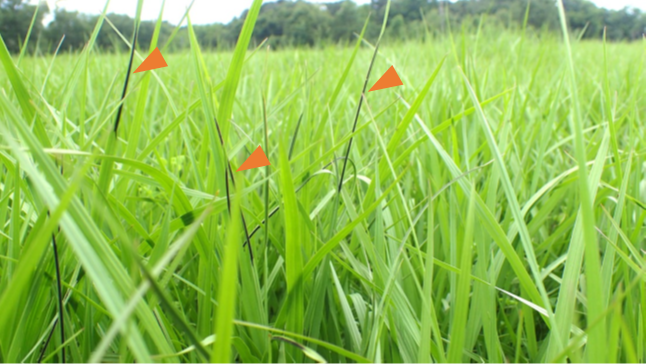Hui-Ling (Sunny) Liao, Cheryl Mackowiak, Ann Blount, Robbie Jones, Joseph Walter, Brittany Justesen, Anna Paulette Tomlinson, Doug Mayo, Carissa Wickens, UF/IFAS Univeristy of Florida
Mycotoxins are secondary metabolites produced by fungi that may cause harm to animals and people who ingest them but typically not to the host plant. They are released by endophytic (inside the plant) and epiphytic (the plant’s outside surfaces) fungi that are commonly associated with forage grasses and grass type weeds. There are dozens of different mycotoxins being discovered but research into mycotoxin types, fungal sources, impacts on livestock health, and mitigation is relatively new and ongoing. Generally, warm and humid conditions favor fungal proliferation in forage grasses. Consequently, this topic is of increasing importance for livestock producers in Florida and the entire Southeast U.S.

Figure 1. Most grass-associated fungi grow in or on grass leaves without producing visible structures or causing noticeable leaf symptoms such as lesions, with only a few exceptions. A commonly observed exception is the epiphytic fungal group (Myriogenospora atramentosa) that form black fungal structures on bahiagrass leaves (orange arrows) Chen et al 2022.
–
Two recent surveys conducted by UF/IFAS researchers and county extension agents investigated the prevalence, seasonal patterns, geographic distribution, and grass species associations of mycotoxins across Florida. Various mycotoxins were detected in bahiagrass, bermudagrass, limpograss, and smutgrass weeds. The most often identified toxins in this survey included fumonisin B1, zearalenone, dihydrolysergol, and emodin. Occasionally, some grass samples—particularly those containing fumonisin B1 or zearalenone—exceeded the safety thresholds established by the Joint FAO/WHO Expert Committee on Food Additives (JECFA), raising some concern among producers and veterinarians about potential livestock health impacts (Liao et al., 2023; 2025).
Preliminary findings indicated that grass fungi prevalence in Florida tends to increase during late spring and early summer, as rising temperatures and humidity create more favorable growing conditions. However, in late summer, these same fungi may experience fluctuating moisture and heat that also may stimulate mycotoxin production. Accumulated mycotoxins in forages can persist in the dry/cooler seasons (fall through early spring), even in pastures that appear visually healthy. These studies highlight the need for continued research on how climate variability and pasture management influence the synthesis and persistence of mycotoxins. Regular monitoring and improved diagnostic tools are critical to mitigate risks and support livestock health management in Florida’s forage-based systems.
If producers observe health issues in cattle that are grazing or consuming hay AND your veterinarian suspects symptoms are related to mycotoxin exposure—there are commercial laboratories available to test forage samples. These labs can typically identify and quantify a small number of well-known toxins within five to ten business days. Once results are available, producers may consult with the UF/IFAS mycotoxin team (The authors of this article) for interpretation and management recommendations, if needed.
–
Tips for Submitting Samples:
- Contact the commercial lab before collection to confirm sample size, packaging instructions, and chain-of-custody forms.
- Clearly specify which mycotoxins you want tested. If the budget is limited, producers can focus on testing for the toxins most commonly found in pastures—such as zearalenone, fumonisins, alternariol, and ochratoxin—especially if a veterinarian identifies symptoms consistent with these toxins.
- For fresh samples (not hay), drying or freezing may be required to preserve sample integrity prior to shipping.
–
Examples of the Commercial laboratories (not an endorsement)
- Dairy One Forage Laboratory (New York)
- Services: Mycotoxin screening (zearalenone, fumonisins, DON, T-2, aflatoxins, etc.)
- Turnaround: 5 – 10 business days
- Website: www.dairyone.com
- Contact: (607) 257-1272, forage@dairyone.com
–
- Trilogy Analytical Laboratory (Missouri)
- Services: Mycotoxin testing using LC-MS/MS, including regulated and emerging (12) toxins (e.g., zearalenone, fumonisins, Deoxynivalenol (DON), T-2, aflatoxins, etc)
- Website: www.trilogylab.com
- Contact: (636) 239-1521, info@trilogylab.com
–
- Romer Labs (Missouri and Iowa)
- Services: Mycotoxin analysis (ELISA, HPLC, LC-MS/MS)
- Website: www.romerlabs.com
- Contact: (636) 583-8600 | office.us@romerlabs.com
–
- Alltech 37+ Lab (Kentucky)
- Services: Offers mycotoxin testing for animal feed, analyzing over 40 mycotoxins using the Alltech 37+® test via LC-MS/MS. Also provides rapid on-site testing with Alltech® RAPIREAD™
- Website: alltech.com
- Contact: Cwinburn@alltech.com (Lab director)
–
References
- Liao, H.-L., et al. (2023). A Preliminary Survey of Mycotoxins Identified from Florida Bahiagrass Pastures. SL505. UF/IFAS Extension.
- Liao, H.-L., et al. (2025). Survey of Mycotoxins Present in Florida Pastures Across Time, Locations, and Grass Species. SL529. UF/IFAS Extension.
- Chen KH, Marcón F, Duringer J, Blount A, Mackowiak C, Liao H-L. Leaf Mycobiome and Mycotoxin Profile of Warm-Season Grasses Structured by Plant Species, Geography, and Apparent Black-Stroma Fungal Structure. Appl Environ Microbiol. 2022 Nov 8;88(21):e0094222.
